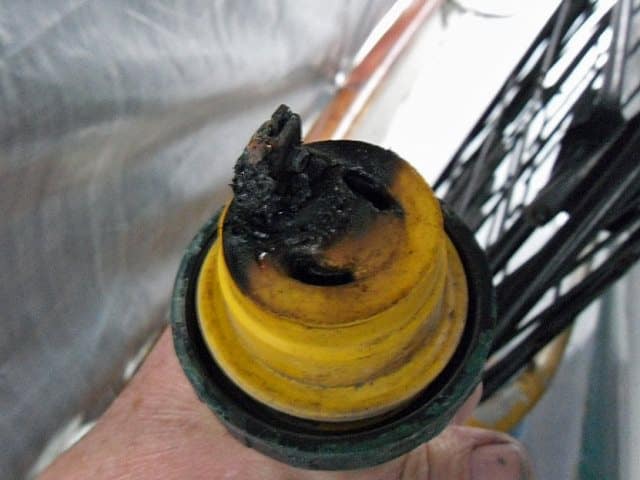
Last week I received a query from a reader asking me what I look for during a comprehensive inspection of a boat’s electrical system. I’ve gotten similar questions from attendees at Cruising World’s annual Boat of the Year (BOTY) competition. So, I thought I’d spend a few minutes creating such a list today. Why? Well I don’t want your boat or any of the parts on it to end up looking like the shore power cord shown in our lead photo.
I should note that during my BOTY inspections I’m actually looking at systems and construction details that go far beyond the electrical side of things, but here I’ll just focus on electrical issues or potential issues. I should also point out that in the BOTY scenario we are looking at European sailboats and the occasional American or Canadian boat.
This is important because the boats are built to CE standards and not necessarily ABYC Standards. There are differences. Anyhow, here’s how the list goes:
- Battery installations. Are they securely mounted so they can’t move in a violent seaway? Are they provided with over-current protection? Are wing nuts used to secure the cables to the battery posts? Are they installed in a dedicated space? Are in a box that won’t get damaged if some electrolyte gets spilled? Is there adequate ventilation for the compartment? Is the available capacity adequate for the task at hand?
- Wire gauge sizes. Especially with the shore power systems. European boats are running at 230 volts. So, the wire can be roughly ½ the size as need for our 120 volt systems. Has the wire been sized correctly? DC wire runs sized to accommodate our maximum voltage drop levels of 3 and 10%. Often the wiring is too small.
- Wire support and chafe protection.
- Wire insulation rated correctly.
- Drip loops and strain relief. Frequently strain relief is inadequate.
- Push on terminal friction adequate? Are the cables secured in such a way that they won’t likely disconnect inadvertently?
- Quality of crimped connectors.
- Location of heat and or water sensitive electrical components. Will they get adequate ventilation and stay dry under real world use?
- Are AC electrical connections made inside enclosures requiring the use of tools to access?
- Is wiring labeled in such a way that circuits can be traced easily?
- Is over-current protection sized for the tasks at hand, including motor circuits and a locked rotor scenario.
- Is lighting running hot? Is heat damage to surrounding areas likely?
- Are AC switches and receptacles mounted in appropriate boxes?
There you have it. My quick check electrical list. Most everything on this list is a quick visual check. Hope this helps!








